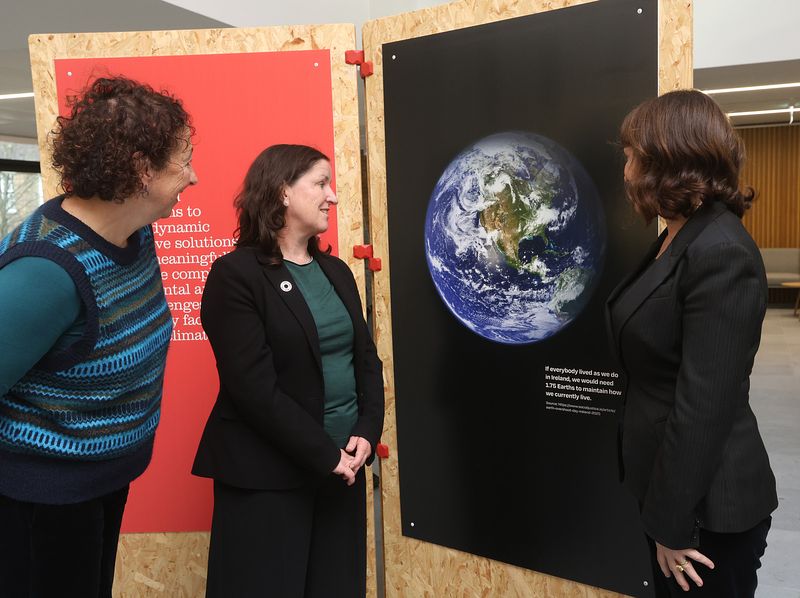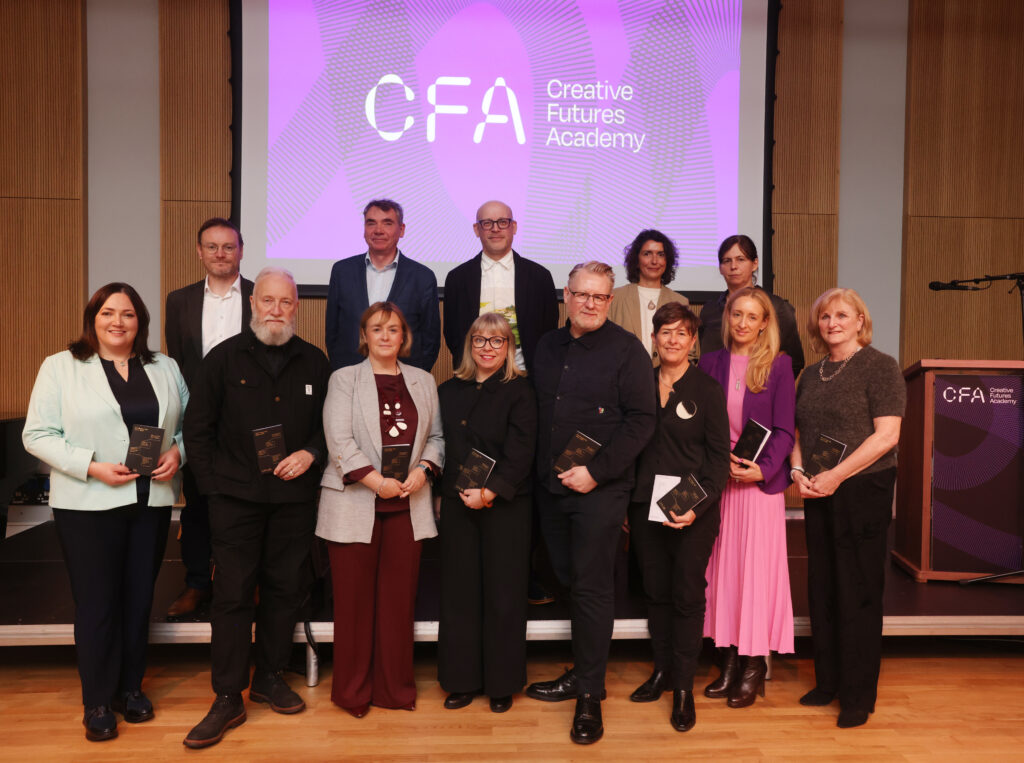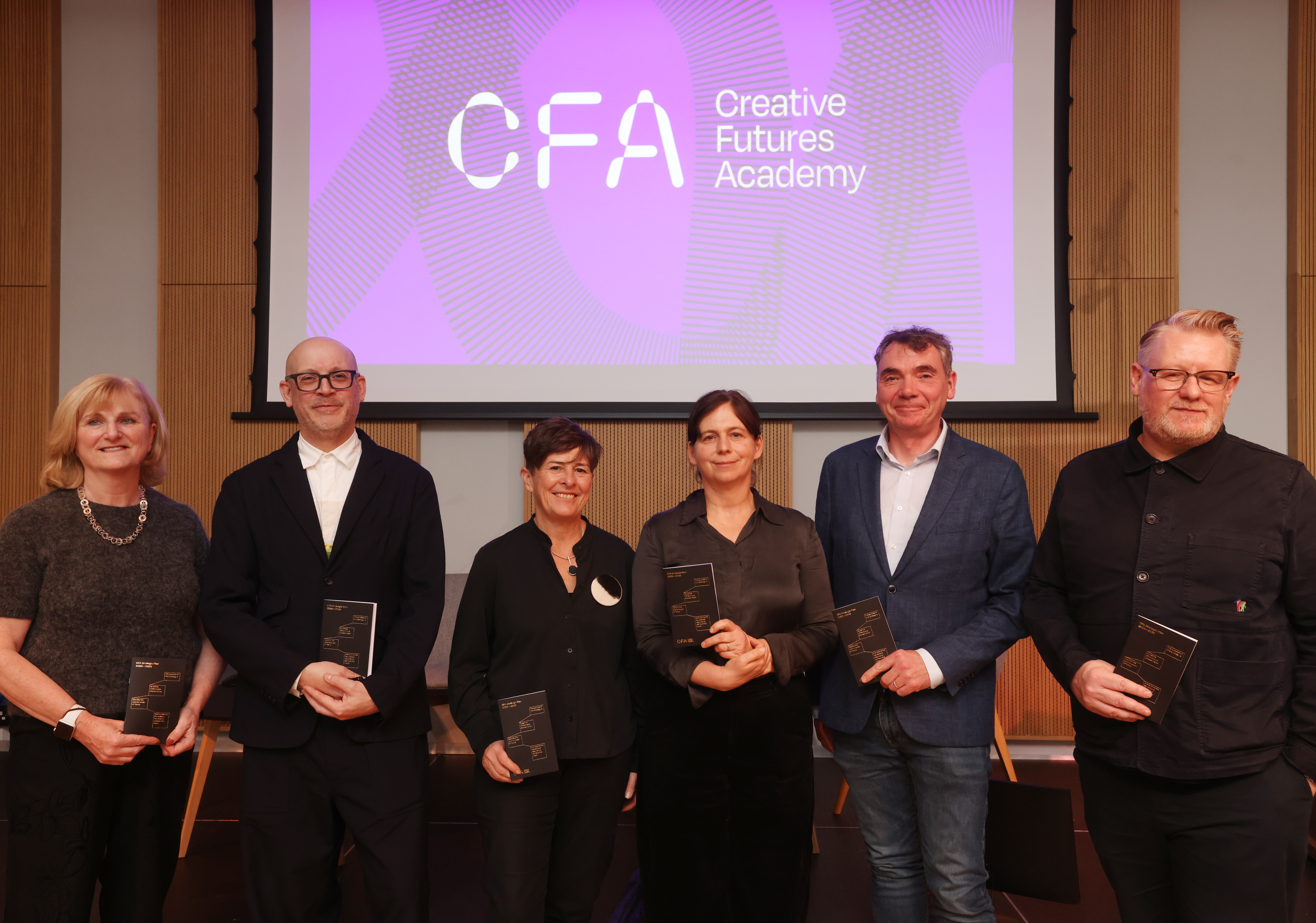


Creative Futures Academy (CFA), a partnership between the National College of Art and Design (NCAD), University College Dublin (UCD), and the Institute of Art, Design + Technology (IADT), hosted its first Industry Breakfast Morning on 3 November at the Royal Irish Academy of Music.
The event, Shaping Ireland’s Creative Future, brought together government, higher education, and creative industry leaders to explore how Ireland can strengthen its creative economy, meet future skills needs, and sustain growth. It also marked the launch of CFA’s new strategy 2026 – 2030, outlining its vision for creative skills development, research, and innovation.
WATCH the full event below.

Ireland’s creative and cultural industries currently contribute €8 billion in gross value added (GVA) — 3.7% of GDP, below the EU average of 5.5%. But the message from the event was clear: Ireland has both the data and the drive to grow.
Dr. Colm O’Reardon, Secretary General at DFHERIS, opened the morning by underlining the power of research and training:
‘Technology rarely stands still. To be on the right side of technological change, we need to understand it and train people to a high level… it requires that we deliver research and research-led teaching. In an era when digitalisation and AI are fundamentally changing the way the creative industries operate, that imperative is greater than ever.’
Keynote speaker, Paul Moore (Future Screens NI) spoke about the importance of a compelling narrative and how we currently tell the story of the creative industries’ impacts.
‘The story and how you tell the story is crucial. The creative industries in NI generates £1.6 billion per annum and is the fastest growing sector with 4.4% of the workforce, and 37,000 employees.’
Quoting Ghanian entrepreneur, Kofi Amoa-Abban, Moore finished his address with the inspiring words:
‘If you have a group of people with a vision and everybody sticks to the vision, and everybody faces the right direction for the future, the future will reach back and pull you into it.’
This collaborative vision recognises creativity not as a stand-alone sector, but as a core engine of Ireland’s innovation economy, connecting talent, technology, and entrepreneurship through research, imagination, and shared purpose.

In panel 1, Seeding Creative Outputs – The Policy Context and Environment for Growth chaired by David Smith (IADT), discussions focused on screen-based media, design, and policy with Paul Moore (Future Screens NI), Dr. Colm O’Reardon (DFHERIS), Ruth Freeman (Research Ireland) and Charlotte Barker (IDI), and how higher education can create value through research, innovation, and entrepreneurship.
Barker emphasised the importance of collaboration between HEI’s, government, industry to help build the infrastructure of future-focused design skills:
‘Collaboration is really key. We all need to be on the same page. I do feel that is where we are at – this is the time where we are building those relationships and there’s lots of opportunities now to really unlock the potential of design.’
Ruth Freeman (Research Ireland) spoke about the importance of research investment and cross-sector collaboration to unlock creative innovation.
Panel 2, Future Skills and the Value of Creativity, chaired by Louise Allen (CFA Director), included Vivienne Patterson (HEA), Barbara Revelli (ELIA), John Lynch (Context Studio), and Deirdre Ní Choistín (TG4) and explored how creative skills are evolving in response to digital transformation, sustainability, and global collaboration.
Ní Choistín captured the global opportunity ahead:
‘We need to look across disciplines for future skills in production, broadcasting and other areas. It is a crucial time for the Irish language in TV and film, and we are seeing its global reach and impact. We also want to keep that talent in the sector. To protect that, we must nurture the next generation of creative talent.’
Since 2020, €10 million HCI investment has enabled CFA to deliver 140+ new and enhanced courses across 180 modules to 5,000+ learners, with 4,000+ industry collaborations. State-of-the-art facilities include the Trapdoor Theatre and Creative Arts Lab (UCD), Dolby Atmos Sound Studio (IADT), and The Walsh 3D Fabrication Facility (NCAD).
At the end of the event, David Smith (IADT), Sarah Glennie (NCAD), Regina Uí Chollatáin (UCD) and Louise Allen (CFA) shared the stage to launch the CFA’s new 2026 – 2030 strategy. The strategy outlines a shared vision for how CFA will continue to deliver responsive learning and research opportunities that support talent development, enhance employability and strengthen the CCI sector.
David Smith reflected:
‘As the creative sector – and society as a whole – adjust to the accelerated pace of change, it is clear that a new policy approach to investment is needed to build capacity for the CCI sector. To this point, the initial HCI investment in Creative Futures Academy is an exemplar in many respects.’
Sarah Glennie added that:
‘The strategy marks a commitment to continue the collaboration between IADT, NCAD and UCD but to also strengthen the ties with industry across the CCI sector. There is a real moment of action right now in Ireland. And CFA’s new strategy outlines our ambition to be a part of that in different and dynamic ways.’
Closing the morning, CFA Director Louise Allen called for continued collaboration and confident storytelling:
‘Our creative and cultural industries have immense potential. This event was about setting a shared agenda and identifying the skills, partnerships, and imagination needed to realise that potential. As a sector, we must tell our stories with confidence and continue to connect creativity to industry, community, and policy.’
The conversation continues in 2026, with future CFA events focusing on the impact, reach, and growth of Ireland’s creative and cultural industries.
Media Contact:
Creative Futures Academy Communications Team
communications@creativefuturesacademy.ie
www.creativefuturesacademy.ie
About Creative Futures Academy
Creative Futures Academy (CFA) is a collaborative initiative between NCAD, UCD, and IADT, offering flexible, industry-informed learning pathways designed to meet Ireland’s future skills and innovation needs.
For more information and to read the full strategy click HERE
Images by Leon Farrell, Photocall Ireland.
